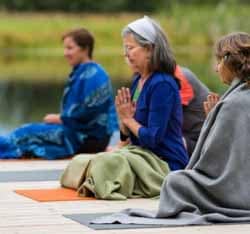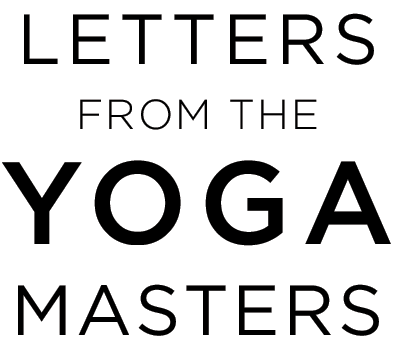A yoga teacher training that includes teachings beyond asana
by Mugs McConnell
Seeking out a yoga teacher training must be one of the most confusing things to do for a yoga student. Most people who desire to become a yoga teacher do so because of the great benefits and joy they have experienced in a yoga asana class. However, there is so much more to yoga, and if only asana is taught, then, in my opinion, we are not honouring the culture and history of yoga. Sadly, the student is being shortchanged on what they could and should be exposed to.
a
If you really want to learn to teach yoga, it is important to understand that asana is only one aspect, and by far not the most important. Patanjali and several other classical figures of yoga teach us that there are 8 important limbs of yoga. A yoga teacher should not only know about these 8 limbs, but be rooted in their practices and able to teach them with skill and expertise.
There are 8 limbs of Yoga
- Yamas & Niyamas are the first two, which are the ethics or the ten commandments of yoga. They are the foundation for your behaviours – things you should do and things you shouldn’t, if you really want to be a practicing yogi. Things like telling the truth, not stealing, cleanliness, and practicing contentment. There’s more, but this gives you the idea.
- Here is where Asana comes in; your stable seat. Being comfortable in your body so you can enjoy health and movement with good circulation, and to sit comfortably for the other, deeper practices.
- Pranayama or control of the life force through breathing techniques. Even though our breathing happens without us thinking about it, we can benefit hugely by paying attention and making use of our lung capacity. There are many practices that play a key role in raising our consciousness to the higher states that we haven’t even thought of, but the yoga masters have known this for centuries!
- Pratyahara is the withdrawal of the senses… our senses draw us outward and away from our inner self. Here we learn to turn inward, away from sensual distractions, even for a moment. There are very easy practices, like yoga nidra, that help one to achieve pratyahara. A yoga teacher should be able to guide the students through this very important bridge to your beautiful spirit within.
- Dharana, or concentration, includes practices like gazing at the candle flame, or a flower. These techniques help to tame the mind and become focused. A wandering mind will struggle with communication, listening, and being present.
- Dhyana or meditation is a deepening of concentration where one experiences spaces between thoughts, where the real meaning of yoga or union begins. Here in these spaces of thoughtlessness is a sublime peace that cannot easily be described, but is far from empty, and very attainable. There are many techniques that help us to move into these spaces of silence, including mudras and japa and visualizations.
- Samadhi, nirvana, or enlightenment at last…. A place of true unconditional bliss, not tied to the pleasures and pains of this world. This is a very healing state of being and comes as a result of practicing well all the other limbs.
 Knowing about these practices is one thing, but knowing how to do them and to teach them is more important for a yoga teacher. In the classical yoga texts it remind us that we can do all the reading we want, but unless we put these into practice it means very little on the path of yoga.
Knowing about these practices is one thing, but knowing how to do them and to teach them is more important for a yoga teacher. In the classical yoga texts it remind us that we can do all the reading we want, but unless we put these into practice it means very little on the path of yoga.
The students in your asana classes don’t need to know all these practices, but very often you will find they want to! It will serve you well to be well versed in these techniques. Then you can taper classes to suit the needs of a variety of students; such as those who want athletic yoga, those who want a spiritual yoga and those who need to breathe more effectively.
The 5 main paths of yoga
Let’s add to this vast abundance of yoga knowledge the fact that there are 5 main pathways of yoga! These are the yoga of compassion and love (bhakti yoga), the yoga of the mind and meditation (raja yoga), the yoga of wisdom (Jnana yoga) and the yoga of selfless action (karma yoga). Then there is the yoga of the body – Hatha yoga – the youngest of them all.
Being well educated as a yoga teacher allows you to still favour the hatha yoga asanas you love! These other limbs will enhance your hatha yoga practice greatly. As you learn more about the other limbs and pathways of yoga, they too will be enhanced by each other. And oh, there is so much more!
Most of your highly respected “rock star” yogis of today did their homework. They are well trained, dedicated teachers with a strong knowledge of yoga beyond asana. You deserve to get that kind of training too, so you get all the pieces of the puzzle. It doesn’t matter what the minimum standard is for a teacher training – set your own standard and do your homework to investigate, like you would if you were choosing a University to attend. Take advantage of the gift of these teachings that the yogis of the past have shared so generously with us, and find a teacher trainer who can really teach them.
I for one believe yoga is life-changing. All the gifts that yoga has to offer have given me a life map. After 45 years of yoga, 40 of those as a teacher, I wouldn’t have lived it any other way. By finding teachers who know the teachings and share them willingly made all the difference,. These beautiful techniques of Yoga have enhanced my faith, increased my confidence, and helped me find my voice. I hope it offers you the same.
 Mugs McConnell is leading a RYT 200 hour yoga teacher training in Calgary Alberta July 4-19th. She has been practicing yoga for 45 years and teaching for 40 years as a classically trained teacher. She is a published author of the highly acclaimed book “Letters from the Yoga Masters”, containing classical teachings passed on to us through the masters of the past. To learn more about her and her book and workshops or trainings visit www.lettersfromtheyogamasters.com
Mugs McConnell is leading a RYT 200 hour yoga teacher training in Calgary Alberta July 4-19th. She has been practicing yoga for 45 years and teaching for 40 years as a classically trained teacher. She is a published author of the highly acclaimed book “Letters from the Yoga Masters”, containing classical teachings passed on to us through the masters of the past. To learn more about her and her book and workshops or trainings visit www.lettersfromtheyogamasters.com

